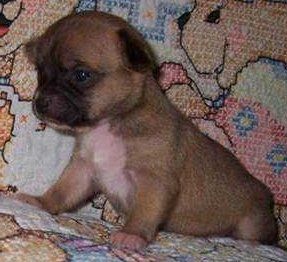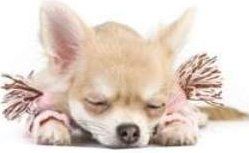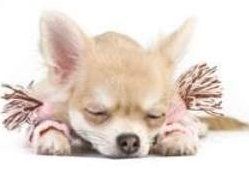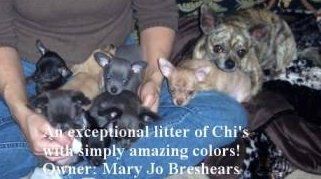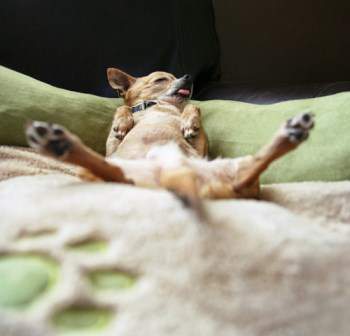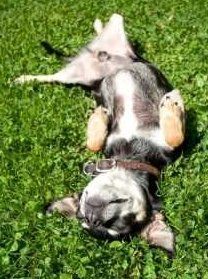Chihuahua Puppy Care
Vaccinations & When Your Puppy is Ready to Go Outside
When you obtain your puppy, he or she should be up-to-date on their shots. You should be given documentation showing this. After choosing a well established and reputable veterinarian, it will then be up to you to schedule regular visits to complete the series.
This is a non-negotiable part of Chihuahua puppy care and your veterinarian will give you a vaccination schedule.
Those who do not vaccinate their puppies are putting those dogs at great risk. There is a lot of talk about "over vaccinating" however to not do so at all is a huge mistake.
The 3rd leading cause of death for this breed is infections (10.5%). This includes parvovirus and distemper for which there are inoculations. Additionally, puppies that live within close proximity to wild life may need a conditional vaccine for Leptospirosis.
Owners wonder how long they must wait before they can take their puppy outside for a walk or into a public place. A Chihuahua should have his complete rounds of puppy shots and then an additional 2 weeks added on to that date before being brought anywhere that other dogs are or may have been. This includes dog parks, pet stores and even walking the route around your neighborhood.
De-Worming
Deworming is a very important care element and should never be overlooked. Since parasites can ravage the body, cause extreme suffering and ultimately be fatal, it is very important to keep up with preventative treatment.
When you bring your puppy home, he or she should have had at least one de-worming.
You should be given documentation showing this. Then, it will be your responsibility to continue with treatments until the series is complete.
Giving your dog all needed preventative medication is very important because heartworm medicine will not work for tapeworms, whipworms and other parasites that can enter quickly into the body and cause great harm. Today, medications will perform 2 functions at the same time: prevention and expulsion.
If a dam has worms (sometimes very hard to detect without medical testing) these can and most often are passed from dam to puppy during birth.
For proper Chihuahua puppy care, this should be done at certain times (and also at times through the dog's life):
- When the puppy is at the 6, 8, 10 and 12 months old marks
- Just before planned breeding and also before whelping
- Older, adult Chihuahuas should have this done 2 times per year
- Anyone who just obtains a Chihuahua not matter what his or her age should de-worm the dog for precautionary measures
The Molera
The Chihuahua is born with a soft area on its head called the Molera. For most dogs, this grows in and bone will form to close this area as the Chihuahua matures.
During the first 6 or 7 months, this area must be touched with care. Sadly, even some veterinarians believe it is normal for the soft spot to remain for life; thus missing a potentially deadly disease.
If your dog has a soft area on his or her head after 7 months, this may be Hydrocephalus and a reputable and experienced vet can perform tests to check for this.
Before You Bring Your Puppy Home
Chihuahua puppies are very small - just a pound or so - and will need the environment to be safe. Also, this breed can have trouble adjusting to new environments. Taking some time to plan ahead can make the transition to a new home go much smoother.
Here are some tips:
1) Have all needed supplies ahead of time
(more ahead). This way, you can concentrate on the puppy without having to rush out of the home.
2) Puppy-proof the home.
It is important to do this not only before you bring the puppy into your household, but also on a regular basis. Any room that the puppy may have access to should be checked for any objects that are small enough to be mouthed; even if you would never think a dog would care to do so.
In addition, any objects that you do not want to be chewed (shoes, pocket books, remote, etc.) should be placed up high and out of reach. Take time to wind and secure electrical cords.
The outside area - particularly where you will be leading the puppy for potty training- should be checked over as well for any sharp objects or any possible hazards.
3) Speak with all members of the family so that there is a clear understanding of who will be responsible for of the different types of care tasks. This includes feeding, walking, grooming and house training. It is best to have a primary caregiver and a backup. Because this breed does not always handle change well, it is best for him to not associate walking with only one particular person. It is best if all chores and tasks are rotated so that the puppy can become accustomed to receiving care from everyone.
4) Control and Limit interaction -
For the first week or so, it is best to limit interaction with primary household members only. While new owners understandably want to show off their new puppy, it is best to allow a Chihuahua to get used to his immediate human family.
Once he feels settled in and a routine has been established, extended family, friends and neighbors can be slowly introduced. A Chihuahua can be shy, often shaking from anxiety if overwhelmed.
Items You Will Need for Your Chihuahua Puppy
There will be certain items that you will need to provide a safe and happy environment for your little puppy.
1) A Playpen or Gates -
When humans are keeping a close eye on the pup, he can roam free in a puppy-proofed home. However, at all other times, the puppy will need a secure and safe enclosure.
A gated off area or a small canine playpen is recommended as opposed to a crate. Being crated during daytime waking hours can be stressful on an active, hyper puppy.
2) Toys -
It's fun to pick out colorful toys; however the goal of obtaining a good toy collection
will serve you well when the puppy begins to teeth.
The teething phase in which milk teeth fall out to be replaced by adult canines will typically occur between the age of 4 to 8 months old.
It is best to obtain teething specific toys. Some will have protrusions that help a puppy reach a certain area of itchy gums and others will be frozen to offer cool, soothing relief to sore gums.
Since puppies can quickly tire of toys, it is recommended to keep two different buckets and rotate them so that the Chihuahua has something 'new' every week or so.
3) Grooming supplies -
This breed needs a moderate amount of grooming with particle attention given to the teeth since the Chihuahua is prone to tooth decay.
- For brushing smooth coats, you'll want a grooming glove, slicker brush or soft bristle brush
- For grooming long haired Chihuahuas, you'll want a wide slicker brush, a wide tooth comb, a water spritz bottle and a pair of scissors for trimming
Brushing the coat on a regular basis is an important part of care. It stimulates the natural oils on the skin, which keeps the coat healthy. It also removes dirt, debris and dead hairs that can block air flow to the skin.
For all Chihuahua puppies, you will want to have:
- Quality canine shampoo and conditioner. Human cleaning products contain a different PH balance than canines require to keep the skin and coat healthy.
- Canine toothpaste and a canine toothbrush - This breed is extremely prone to tooth decay and for this reason, daily dental care is highly recommended. It only takes a few minutes to properly brush the teeth and most puppies - when introduced to this early - do very well in tolerating it.
4) Harness, leash and collar - While most owners only think of a collar as a needed accessory, this breed has very different needs. The Chihuahua is very prone to Collapsed Trachea - a condition in the rings of cartilage that surround the windpipe are damaged or collapse inward. This causes breathing difficulty, discomfort and coughing with a long recovery period.
It only takes a second for a puppy (or older dog) to be on leash and collar, and lunge to the side or jump up ahead. If this happens and the leash was held taut, all of the pressure and force is put directly on the puppy's neck. This can instantly crush the windpipe.
When a harness is used instead, if the puppy runs ahead, lunges out, jumps to the side or makes any other action that would otherwise put pressure on the neck, the harness
distributes any pressure across the chest, shoulders and back. This greatly reduces possible injury and keeps the puppy safe. Owners find that with a harness, they have much better control with their dog, which leads to more pleasant walks and easier training in regard to heeling.
A collar can certainly be used as well, this would be to hold the dog's ID and is perfectly fine as long as it is not attached to the leash.
Both a 6 foot and a 12 foot leash is recommended - The 6 foot leash works very well for housebreaking purposes and for walks. The 12 foot leash works well for outside activities where you want to allow your Chihuahua puppy to have more of a feeling of freedom and ability to run around, while ensuring his or her safety.
5) Food -
Most likely, the food that you choose will differ from the one that the breeder (or previous owner) of your puppy was feeding to him or her. However, any change must be done slowly and gradually, over the course of at least one month.
You never want to run out and have to fed your puppy something that is not healthy for him, so once you find the flavors that your puppy loves, stock up.
For growing puppies, providing a very high quality food is so important for proper Chihuahua puppy care. You may wish to learn more about this in the section: What to feed a Chihuahua. For newborn puppies that have not yet transitioned over to solid food, you will want to read about weaning a Chihuahua.
6) Food & Water Bowls -
There are actually a couple of different elements to keep in mind for what one may think is an easy part of Chihuahua puppy care. Deeply colored plastic bowls can cause staining to the fur, particularly on the facial hairs of a dog of any age.
Additionally, the heavy dyes used in these products can slowly leak into food and water, triggering an allergic reaction. Best would be to use ceramic or stainless steel.
The size is important as well. Due to the small body structure of the Chihuahua, you will want to obtain very shallow dishes or bowls
so that the puppy is not able to accidentally bump his head against the rim.
7) Blankets -
Baby blankets can come in handy. They should be placed inside the pen and rotated so that their is always a fresh, clean one. Hygiene is important with blankets or any washable items that your puppy will be resting upon or is in contact with on a daily basis. Dust, dirt, food particles, urine, feces and other elements can be a breeding ground for bacteria and also be the trigger for allergies.
Blankets should be washed only with hypo-allergenic detergent. You may wish to read more in the allergy section.
Care Tips to Keep Your Chihuahua Happy & Healthy
While there are many tasks that need to be done in order to properly care for a Chihuahua puppy, knowing what needs to be done when and having a schedule can be very helpful.
Feeding -
A puppy under the age of 4 months should be free-fed. This means that fresh food is left out at all times in a designated area. A Chihuahua puppy does best with small amounts of food spread out over the day. With a high metabolism and tons of energy, this will help the puppy stay fueled.
Puppies from the age of 4 months to 1 year should have 3 meals per day. Spreading meals out also helps with preventing hypoglycemia. Hypoglycemia is a health condition that all toys breeds are prone to and especially puppies. This rapid drop in blood sugar can happen to the best cared for puppies.
Warning signs are weakness, dizziness, instability of the feet and trouble walking. Treatment includes rubbing a drop of honey into the gums and then possible IV treatment at an veterinary clinic.
Adults do best with 2 meals per day; though some still require 3. Snacks and treats
can be reserved for reinforcing good behavioral habits.
Baths -
Baths should be given every 3 weeks regardless of whether the puppy appears to be clean. There will be a buildup of oils, dirt, dust and debris that will need to be scrubbed out of the coat. Baths are best done in the sink with a non-slip rubber mat placed at the bottom.
Have all needed supplies
close at hand and a warm towel waiting for when the bath is done. It is best to give the coat a brushing right before washing in order to remove dead hairs that are trapped near the skin, so that the shampoo can reach all the way down into the coat.
Exercise
- Once all puppy shots have been given and 2 weeks has passed after that date, you will be able to safely walk your Chihuahua puppy out in public. With a harness on to keep the neck safe from injury and clothing - if it is cold outside - it will be time to bring your puppy for at least one 2- minute walk per day. Though two walks are recommended for hyper, active pups.
Even if a puppy runs around the house and appears to be very active indoors, providing daily outdoor exercise is suggested. A change in scenery and and fresh air works well to allow a Chihuahua puppy to relieve pent-up energy and satisfy his instinct to explore. It is also an important part of socialization; to gradually introduce a dog to various elements of the world around him.
Do keep in mind that young puppies under the age of 1 year old should not be over-exercised. Too much running and other activity that puts stress on the body can interfere with growth plates.
Sleep -
Puppies can sleep quite a bit. Adult dogs sleep an average of 13 hours. A young puppy may sleep anywhere from 17 to 21 hours per day. This includes both nighttime sleep and naps taken throughout the day. Each month as the puppy matures, he will require less sleep until he reaches the 11 to 14 hour mark as an adult.
If a puppy has a hard time sleeping at night, this can be due to needing more stimulation during the day. Going from one walk to two can be helpful. Also, you may want to incorporate command training and even agility training; both activities that will tire out a puppy and keep his day fuller so that sleeping at night is more appealing.
While it is hard to resist the instinct to rush over to a whimpering puppy in the middle of the night, it is important to allow a Chihuahua puppy the opportunity to self-sooth. When each whimper is met with attention, the puppy will rarely stop calling out for his owners. As long as you know that there is not a chance that the pup needs to go to the bathroom and that he is safe and secure, it is fine to ignore barking, yelping or whining.
Have a Schedule -
Have a set schedule will help both you and your dog. While it can help to keep you organized, it will also aid in making a Chihuahua feel more safe and secure.
Canines have an uncanny ability to keep an amazing internal time clock. They know when the food bowl should be placed down and will hold you accountable if you are sitting on the sofa when they expect to be taken for a walk.
When a dog know what to expect and when to expect it, behavior is better overall. For example, an otherwise restless and barking puppy often is a much calmer and well-behaved dog if he knows that he will soon be taken outside for a game of fetch, taught commands and then brought back indoors for dinner.
When there are set times for grooming, feeding, walks, play, command training and even family time relaxing in front of the TV, this gives a dog a sense of order... And Chihuahuas like that.
Keep Veterinarian Appointments -
Going the the vet is not reserved for ill or injured puppies. Preventive care will go a long way in extending the life span of your Chihuahua. When a health problem is caught early, this gives the dog a much better chance for a successful recovery.
Everything from impacted anal glands to ingrown nails to tooth decay can be treated at the clinic and these are just a few of the issues that owners may not notice right away.
Noise and Traffic Level - While it is important for a Chihuahua to be gradually introduced to the world around him, this breed does not do well with a sudden influx of noise, people and other dogs. It can be very overwhelming. Negative experiences can shadow a dog, causing reluctance to enter into a future situation and/or avoid certain people and events.
Many owners find it useful to choose one new element a month to introduce their puppy to. This could be to a neighbor's dog for a play date, a new dog park or even a new walking route.
When at home, try to be mindful of noise levels that may disturb the puppy. While no one must walk on tiptoes, very loud TV's, stereos or other noises can scare a young puppy that is trying to adjust to his surroundings and feel safe in his new home.

